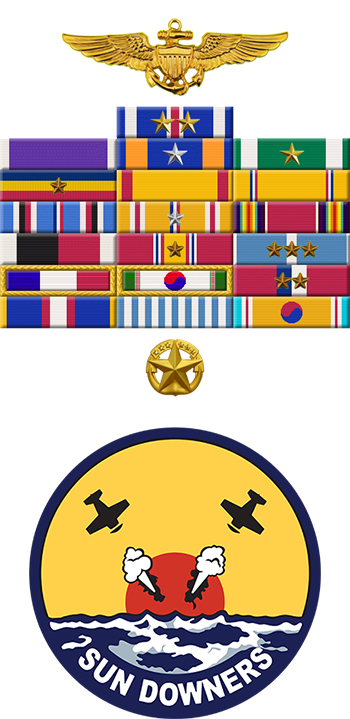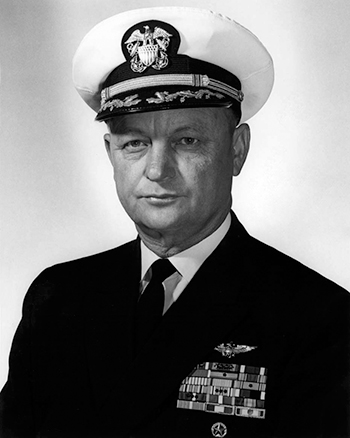
|
Jimmie E. "Doc" Savage |
 |
|||
| Rank, Service | ||||
Captain O-6, U.S. Navy |
||||
| Veteran of: | ||||
|
||||
| Tribute: | ||||
Jimmie Savage was born on October 26, 1918, in Gunter, Texas. He attended North Texas State College in Denton, Texas, from 1938 until he graduated early by attending summer classes in January 1941, earning his bachelor's degree in economics. Savage enlisted in the Aviation Cadet Program of the U.S. Navy on March 10, 1941, was commissioned an Ensign in the U.S. Navy on October 2, 1941, and was designated a Naval Aviator at NAS Pensacola, Florida, on November 21, 1941. His first assignment was as a Flight Instructor at NAS Pensacola from December 1941 to October 1943, followed by service as an F6F-5 Hellcat pilot with VF-11 aboard the aircraft carrier USS Hornet (CV-12) from October 1943 to February 1945. During this time, LT Savage was credited with the destruction of 7 enemy aircraft in aerial combat, plus 1 probable, and 14 more destroyed on the ground while strafing enemy airfields, between October and December 1944. He served as an F4U-1A Corsair pilot and Executive Officer of VBF-98 at NAS Los Alamitos, California, from March to October 1945, and then as a Flight Instructor at Cuddihy Field, NAS Corpus Christi, Texas, from December 1945 to June 1947. LCDR Savage attended General Line School at Newport, Rhode Island, from July 1947 to July 1948, and then served on the staff of the Commander, Naval Air Forces, Pacific Fleet at NAS North Island, California, from August 1948 to December 1949. His next assignment was as an AD-1 Skyraider pilot with VA-114 aboard the aircraft carrier USS Valley Forge (CV-45) from December 1949 to November 1950, and during this time he participated in the first carrier-borne attacks of the Korean War from July to November 1950. He served a brief exchange tour with the U.S. Air Force from December 1950 to January 1951, serving as an F-86 Sabre pilot and Operations Officer with the 33rd Fighter-Interceptor Group at Otis AFB, Massachusetts. Commander Savage's next assignment was as Operations Officer at Naval Air Facility China Lake, California, from February 1951 to May 1953, followed by service as an F9F-6 Cougar pilot and Commanding Officer of VF-121 aboard the attack aircraft carrier USS Boxer (CVA-21) from May 1953 to November 1954. During this time he participated in an escort flight for a reconnaissance mission during the First Indochina War over Vietnam on April 7, 1954. He served as Operations Officer at NAAS Kingsville, Texas, from December 1954 to February 1956, and then as Air Officer aboard the attack aircraft carrier USS Hornet (CVA-12) from March 1956 to August 1958. His next assignment was as Operations/Plans Officer with CVG-12 aboard USS Hornet from August 1958 to October 1959, followed by service as a CVG Training Officer with the Commander Fleet Air at NAS San Diego, California, from November 1959 to September 1960. He attended Naval War College at Naval Station Newport, Rhode Island, from September 1960 to June 1961, and then served on the staff of the Chief of Naval Operations at the Pentagon from July 1961 to July 1963. Captain Savage next served as Director of Navy Recruiting for the Seventh Area at Dallas, Texas, from August 1963 to September 1968, followed by service as Commanding Officer of NAS Dallas, Texas, from September 1968 to February 1971. He then served as Deputy Director of Navy Recruiting for the Seventh Area at Dallas from February to July 1971, and finally as a Special Project Officer on the staff of Commandant, Eighth Naval District, in Washington, D.C., from August 1971 until his retirement from the Navy on March 3, 1972. Jimmie Savage Flew West on April 15, 1984, and was buried at Whitaker Cemetery in Gunter, Texas. He served as President of the American Fighter Aces Association from 1967 to 1968. |
||||
|
||||

